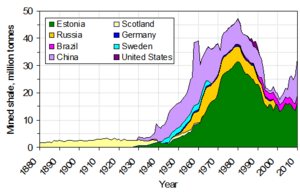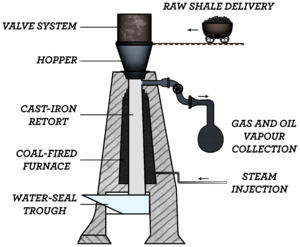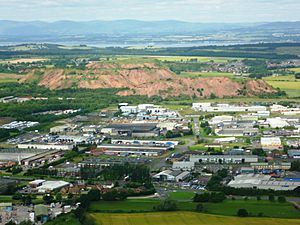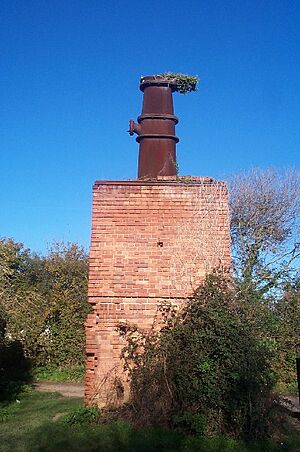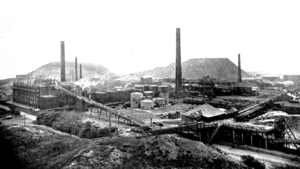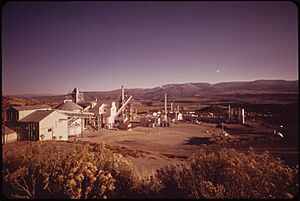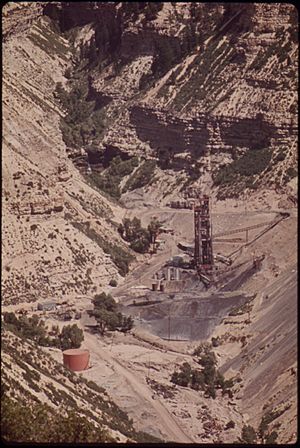History of the oil shale industry facts for kids
The history of the oil shale industry is a story about how people have used a special type of rock called oil shale. This rock can be heated to get oil, which is called shale oil. People have used oil shale for a very long time, even in ancient times.
The modern way of getting oil from shale started in the mid-1800s. It really grew just before World War I. This was because more and more cars and trucks were being made. People thought there might not be enough regular gasoline for all these new vehicles. After World War II, the oil shale industry slowed down. This happened because it became easier to find and get regular crude oil, which was cheaper. By 2010, only a few countries like Estonia, China, and Brazil were still using oil shale a lot. Many other countries are now thinking about using it again.
Contents
Ancient Uses of Oil Shale
Humans have used oil shale as a fuel for thousands of years. It burns easily without much work. People also used it for decorations and building. In the Iron Age, people in Britain polished oil shale to make ornaments. Around 3000 BC, "rock oil" was used in Mesopotamia. They used it to build roads and to stick things together in buildings.
Oil shale was also a popular material for art. It was used in Ancient Greece, the Roman Empire, and later empires like the Byzantine and Abbasid. They used it to decorate mosaics and floors in palaces, churches, and mosques.
Shale oil was also used for health and fighting. People in Mesopotamia used it as medicine. They also used it to seal ships, like caulking. Mongols put flaming oil shale on their arrows. In the 900s, an Arabian doctor named Masawaih al-Mardini wrote about how to get oil from a "bituminous shale." The first time shale oil was used in Switzerland and Austria was in the early 1300s. In 1350, a knight named Berthold von Ebenhausen got the right to use oil shale in Tyrol. They heated crushed oil shale in special pots called crucibles to get the oil. In 1596, a doctor noticed that oil from oil shale had healing powers.
In Sweden, a type of oil shale called alum shale was used in 1637. They roasted it to get a chemical called potassium aluminium sulfate. In Italy, shale oil lit the streets of Modena in the early 1600s. In 1694, the British Crown gave a patent to three people. They found a way to get "pitch, tarr, and oyle out of a sort of stone." This oil was sold as Betton's British Oil. People said it helped with "Aches and Pains." In 1781, Archibald Cochrane got a patent for a way to make tar, pitch, and oil from coal and oil shale.
In Russia, Peter the Great started looking into oil shale in 1697. In 1809, information about Ukhta oil shale was published. In 1830, Germain Henri Hess studied Baltic oil shales. In Australia, oil shale was first mentioned in 1807.
Beginning of the Modern Industry
The modern way of getting oil from shale started in France in 1837. This is when they began mining oil shale in Autun. Shale oil production started in 1838 using a method invented by Alexander Selligue. In 1846, a Canadian doctor named Abraham Pineo Gesner found a way to get a lighting liquid from coal and oil shale. In 1847, a Scottish chemist named James Young made "lighting oil," lubricating oil, and wax from a type of coal. Later, in 1862, he used torbanite, another oil shale.
In 1850, Young patented his method for heating oil shale to get oil. He also patented how to clean the oil and get paraffin wax. In 1859, Robert Bell started getting shale oil from a type of oil shale called lamosite in Scotland. After Young's patent ended in 1862, many small shale oil factories opened. By 1865, Scotland had about 120 shale oil factories.
In the United States, the early oil shale industry focused on deposits in the east. In 1855, an oil factory was built in Kentucky. It made oil from a type of coal called cannel coal. By 1860, there were 55 companies in the U.S. making oil from this coal. However, in 1859, cheap and plentiful regular oil was found in Pennsylvania. This caused the American oil shale industry to close down by 1860. The largest oil shale deposit, called Green River Formation, was found by accident in 1874. But it wasn't used until the early 1900s.
In 1857, the oil shale industry started in Germany. In Canada, a factory started heating oil shale in 1859. But by 1861, it was too expensive because regular oil was found nearby.
In Australia, the first oil shale mine opened in 1865. The first shale oil was made there in the same year. More mines and factories opened in New South Wales. But they closed in the early 1900s because cheaper crude oil was imported.
In Austria, oil shale was used from 1840 to 1882 to make asphalt. In Sweden, the first try to get oil from alum shale was in 1864. Shale oil production started in the 1890s but only lasted a few years. In Brazil, oil shale was first used in 1884. In 1900, New Zealand also started a shale oil industry.
In 1894, the Pumpherston retort was invented. This was a big step for the oil shale industry. It was used until 1938. In the 1800s, these operations mainly made kerosene, lamp oil, and paraffin wax. These products helped meet the growing need for lighting during the Industrial Revolution. They also made fuel oil, lubricating oil, and fertilizer.
Early 1900s Developments
The oil shale industry grew a lot just before World War I. This was because there was less regular oil available. Also, more and more cars and trucks were being made, which needed a lot of gasoline. Oil shale production in Scotland was highest from 1910 to 1912. It produced over three million tons. At that time, Scotland's shale oil industry made up 2% of all the oil produced in the world. After that, production went down, except during World War II. In 1919, five oil shale companies in Scotland joined together to form Scottish Oils.
In the United States, the government started creating oil shale reserves in 1909. These reserves were meant to be an emergency fuel source for the military, especially the Navy. The government set aside land in Colorado for this. The first try to get oil from these western deposits was in Nevada in 1915. It wasn't a business success. In 1916, the first company was set up to use the Green River Formation deposit. They built the first commercial factory in Colorado in 1917. But these attempts also failed. By 1926, the company had lost its property. Other big oil companies also started oil shale operations around 1918–1920. About 200 companies were started to use oil shale. At least 25 different ways to get oil from shale were tested. But then, large amounts of regular oil were found in Texas. This ended the oil shale boom.
During World War I, the German Army made shale oil in Jordan. They used it to power the Hejaz Railway. In 1915, an oil shale industry started in Switzerland. Around 1920, a small factory opened in Sweden. In 1922, another small factory opened in Spain.
The year 1916 is seen as the start of the Estonian oil shale industry. Geologists were sent to Estonia to organize mining oil shale. In June 1916, the first oil shale was mined. It was sent for large experiments. In 1917, a paleontologist named Mikhail Zalessky named the oil shale "kukersite." This was after the Kukruse settlement. Mining continued after that. At first, oil shale was used in cement factories, for train engines, and as home fuel. Later, it was used to make shale oil and electricity. By 1925, all trains in Estonia used oil shale. The first experimental oil shale factories were built in 1921. In 1924, the Tallinn Power Plant was the first power plant in the world to use oil shale as its main fuel. By 1939, Estonia mined 1.453 million tons of oil shale. It made 181,000 tons of shale oil. Almost half of Estonia's shale oil was exported.
In China, oil shale extraction started in 1926 under Japanese rule. Large-scale production began in 1930 in Fushun. In Russia, oil shale was mined and processed near Syzran from 1919–1924 and again from 1929. In 1934, a new oil shale mine opened. Shale oil production started in 1939. Power stations in Russia also started using oil shale as fuel. In South Africa, different attempts to use oil shale were made since the early 1900s. In 1935, a company opened a shale oil plant in Ermelo.
Between the World Wars, oil shale projects also restarted in Brazil and, for a short time, in Canada.
World War II Impact
From 1939 to 1945, a pilot shale oil plant worked in Morocco. In Australia, shale oil production restarted just before World War II. In 1937, the National Oil Proprietary company was created. The Glen Davis Shale Oil Works became the main facility in Australia in 1940. Also, from 1940 to 1952, three special retorts were used in New South Wales.
In Sweden, a company called Svenska skifferolje AB (Swedish Shale Oil Company) was formed in 1940. They used a special method to gasify oil shale underground. This happened between 1940 and 1966.
During the German occupation of Estonia, Estonia's oil shale industry was taken over by a German company. The main goal was to produce oil for the German Army.
In Germany, shale oil extraction started in a cement factory in 1940. Later, a project called Operation Desert was started. It aimed to get oil from oil shale deposits. But only four out of ten planned factories became active. The method they used was very basic and didn't get much oil.
In 1944, the United States started the Synthetic Liquid Fuels Program. The goal was to create a fuel supply from oil shale within the country. Research began on mining and developing new ways to get oil from shale. In 1943, Mobil Oil built a pilot plant. In 1944, Union built an experimental oil shale retort. In 1945, Texaco started studying how to refine shale oil.
Mid-20th Century: Decline and Growth
After World War II, the oil shale industries in Estonia, Russia, and China kept growing. But most other countries stopped their projects. This was because it was too expensive to process oil shale. Also, cheaper regular oil was easy to find. Australia stopped in 1952, France in 1957, Britain and South Africa in 1962, and Sweden and Spain in 1966. In Germany, only one company continued using oil shale for cement and energy.
After World War II, the Soviet Union took control of Estonia's oil shale industry. They rebuilt factories and mines. German prisoners of war did most of the work. New types of retorts were built in the 1950s. Since 1948, oil shale gas from Estonia was used in Leningrad (now Saint Petersburg) and northern Estonia. It replaced natural gas. In 1949, the Kohtla-Järve Power Plant opened in Estonia. It was the first power plant in the world to use crushed oil shale on a large scale. The world's two largest oil shale power stations opened in 1965 and 1973. By 1965, Estonia produced a lot of oil shale gas and mined 16.5 million tons of oil shale.
In Russia, a plant was built to supply oil shale gas to Leningrad. The first part of a power plant using oil shale opened in 1952. From 1955 to 2003, this plant also made shale oil.
In China, a new factory started production in 1954. By 1959, the most shale oil produced in a year reached 780,000 tons. This shale oil was used to make light liquid fuels. In 1961, China got one-third of its total oil from oil shale. After that, shale oil production went down. This was because a large regular oil field was found, and cheaper oil became available.
In 1951, the United States Department of Defense became interested in oil shale. They saw it as a way to make jet fuel. The U.S. Bureau of Mines continued its research until 1956. They operated a small mine. In the 1960s, a plan called Project Bronco was suggested. It involved using a nuclear explosive to break up rock underground. This plan was stopped in 1968. Other companies also worked on experimental ways to get oil from shale underground.
Unocal Corporation started developing its own oil shale process in the late 1940s. This technology was tested from 1954 to 1958. But production stopped in 1961 because it was too expensive. In 1957, Texaco built a pilot plant to develop its own process. In the early 1960s, TOSCO (The Oil Shale Corporation) opened a mine and built an experimental plant in Colorado. It closed in 1972 because the cost of making oil from shale was higher than the cost of imported regular oil.
1970s and 1980s: Ups and Downs
Because of the 1973 oil crisis, the oil shale industry started up again in several countries. The U.S. Navy began looking at oil shale for military fuels like jet fuel. A special jet fuel made from shale oil was produced until the early 1990s. Seventeen companies formed a group to develop a process called Paraho. Production started in 1974 but closed in 1978. In 1974, the U.S. government announced a program to lease land for oil shale in Colorado and Utah. In 1980, the Synthetic Fuels Corporation was created.
In 1972, the first underground oil shale experiment in the U.S. was done by Occidental Petroleum. Other companies also tried similar underground methods. But in 1985, one company stopped its operations. Another partnership existed from 1974 to 1986 to develop land in Utah.
In 1977, Superior Oil Company canceled its oil shale project. A year later, other companies left the Colony Shale Oil Project in Colorado. The U.S. oil shale industry collapsed when oil prices fell in the early 1980s. On May 2, 1982, called "Black Sunday," Exxon canceled the Colony project. This was due to low oil prices and high costs. More than 2,000 workers lost their jobs. In 1986, President Ronald Reagan signed a law that ended the U.S. Synthetic Liquid Fuels Program. The last oil shale factory in the United States closed in 1991.
Because oil shale was good for making electricity, Estonian oil shale mining reached its highest point in 1980. It produced 31.35 million tons. Electricity production from oil shale also peaked at the same time. The largest oil shale mine in the world opened in Estonia in 1972. The industry then declined for the next two decades. This was partly because new nuclear power stations were built in the Soviet Union.
In Israel, a small oil shale power plant was tested from 1982 to 1986. A larger demonstration plant started working in 1989. In Romania, a large oil shale power plant operated from 1983 to 1988. But it was shut down because it was not efficient and had problems. In Brazil, a large test plant started in 1972. It began limited commercial use in 1980. A pilot plant using Petrosix technology started in 1982. A commercial factory began service in 1991.
Recent Developments
The global oil shale industry started to grow a little in the mid-1990s. However, most of the industries in Russia stopped. Oil shale power stations were changed to use natural gas and fuel oil. Only one processing plant continued to use oil shale for a special chemical.
Existing shale oil factories in China closed in the early 1990s. But new shale oil plants have been built. They have many retorts, and their yearly production has increased to 350,000 tons of shale oil. Other projects have also started. In 2005, China became the largest shale oil producer in the world. More companies got involved in getting oil from shale.
After a decrease in the early 1990s, Estonian oil shale production has grown steadily since 1995. Several new processing plants have been built. In 2006, one billion tons of oil shale had been mined in Estonia. This was 90 years after major mining began. Construction of a new 300 MW oil shale power plant began in 2012.
In Australia, a demonstration plant used a special technology to process oil shale. It produced over 1.5 million barrels of shale oil between 2000 and 2004. In 2008–2009, the plant was taken apart. A new demonstration plant opened in September 2011.
In the United States, an oil shale development program started in 2003. A law in 2005 allowed companies to lease public lands for oil shale. In 2007, leases were given to several companies. More leases were given in 2010. Other companies work on private lands. However, some companies closed their oil shale projects in 2012 and 2013.
Since 2006, the government of Jordan has signed agreements with foreign companies for shale oil production. These include Shell and Eesti Energia. In 2008, an agreement was signed to build a 460 MW oil shale power plant in Jordan.
In 2005, Morocco started a new plan for oil shale activities. Since then, agreements have been signed with companies like Petrobras and Total S.A.. In April 2010, a workshop on using oil shale cleanly was held in Egypt. Later that month, an Oil Shale Cooperation Center was set up in Amman. It included Egypt, Jordan, Morocco, Syria, and Turkey. In 2011, Israel closed its Mishor Rotem Power Station.
In 2013, Uzbekistan's national oil company started building a shale oil extraction plant.
See also
- History of the oil shale industry in the United States
- List of shale oil operations in Australia
- Oil shale reserves


